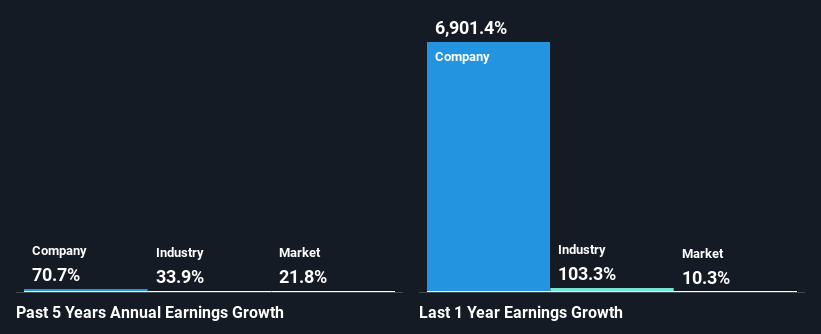Hemisphere Energy Corporation's (CVE:HME) Fundamentals Look Pretty Strong: Could The Market Be Wrong About The Stock?
Hemisphere Energy (CVE:HME) has had a rough three months with its share price down 11%. But if you pay close attention, you might gather that its strong financials could mean that the stock could potentially see an increase in value in the long-term, given how markets usually reward companies with good financial health. Particularly, we will be paying attention to Hemisphere Energy's ROE today.
Return on equity or ROE is a key measure used to assess how efficiently a company's management is utilizing the company's capital. In other words, it is a profitability ratio which measures the rate of return on the capital provided by the company's shareholders.
View our latest analysis for Hemisphere Energy
How Is ROE Calculated?
Return on equity can be calculated by using the formula:
Return on Equity = Net Profit (from continuing operations) ÷ Shareholders' Equity
So, based on the above formula, the ROE for Hemisphere Energy is:
47% = CA$23m ÷ CA$50m (Based on the trailing twelve months to September 2022).
The 'return' refers to a company's earnings over the last year. Another way to think of that is that for every CA$1 worth of equity, the company was able to earn CA$0.47 in profit.
What Is The Relationship Between ROE And Earnings Growth?
We have already established that ROE serves as an efficient profit-generating gauge for a company's future earnings. Based on how much of its profits the company chooses to reinvest or "retain", we are then able to evaluate a company's future ability to generate profits. Assuming everything else remains unchanged, the higher the ROE and profit retention, the higher the growth rate of a company compared to companies that don't necessarily bear these characteristics.
A Side By Side comparison of Hemisphere Energy's Earnings Growth And 47% ROE
First thing first, we like that Hemisphere Energy has an impressive ROE. Secondly, even when compared to the industry average of 26% the company's ROE is quite impressive. Under the circumstances, Hemisphere Energy's considerable five year net income growth of 71% was to be expected.
Next, on comparing with the industry net income growth, we found that Hemisphere Energy's growth is quite high when compared to the industry average growth of 34% in the same period, which is great to see.
The basis for attaching value to a company is, to a great extent, tied to its earnings growth. It’s important for an investor to know whether the market has priced in the company's expected earnings growth (or decline). This then helps them determine if the stock is placed for a bright or bleak future. If you're wondering about Hemisphere Energy's's valuation, check out this gauge of its price-to-earnings ratio, as compared to its industry.
Is Hemisphere Energy Making Efficient Use Of Its Profits?
Hemisphere Energy has a really low three-year median payout ratio of 14%, meaning that it has the remaining 86% left over to reinvest into its business. So it looks like Hemisphere Energy is reinvesting profits heavily to grow its business, which shows in its earnings growth.
While Hemisphere Energy has been growing its earnings, it only recently started to pay dividends which likely means that the company decided to impress new and existing shareholders with a dividend. Looking at the current analyst consensus data, we can see that the company's future payout ratio is expected to rise to 40% over the next three years.
Summary
On the whole, we feel that Hemisphere Energy's performance has been quite good. Specifically, we like that the company is reinvesting a huge chunk of its profits at a high rate of return. This of course has caused the company to see substantial growth in its earnings. If the company continues to grow its earnings the way it has, that could have a positive impact on its share price given how earnings per share influence long-term share prices. Remember, the price of a stock is also dependent on the perceived risk. Therefore investors must keep themselves informed about the risks involved before investing in any company. Our risks dashboard would have the 3 risks we have identified for Hemisphere Energy.
Have feedback on this article? Concerned about the content? Get in touch with us directly. Alternatively, email editorial-team (at) simplywallst.com.
This article by Simply Wall St is general in nature. We provide commentary based on historical data and analyst forecasts only using an unbiased methodology and our articles are not intended to be financial advice. It does not constitute a recommendation to buy or sell any stock, and does not take account of your objectives, or your financial situation. We aim to bring you long-term focused analysis driven by fundamental data. Note that our analysis may not factor in the latest price-sensitive company announcements or qualitative material. Simply Wall St has no position in any stocks mentioned.
Join A Paid User Research Session
You’ll receive a US$30 Amazon Gift card for 1 hour of your time while helping us build better investing tools for the individual investors like yourself. Sign up here

 Yahoo Finance
Yahoo Finance 
